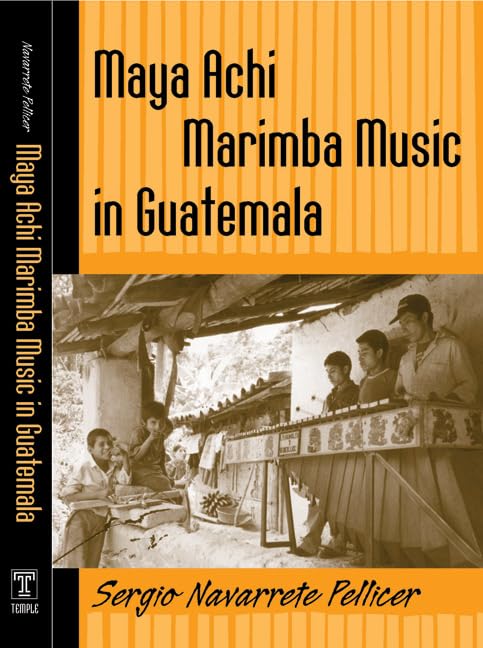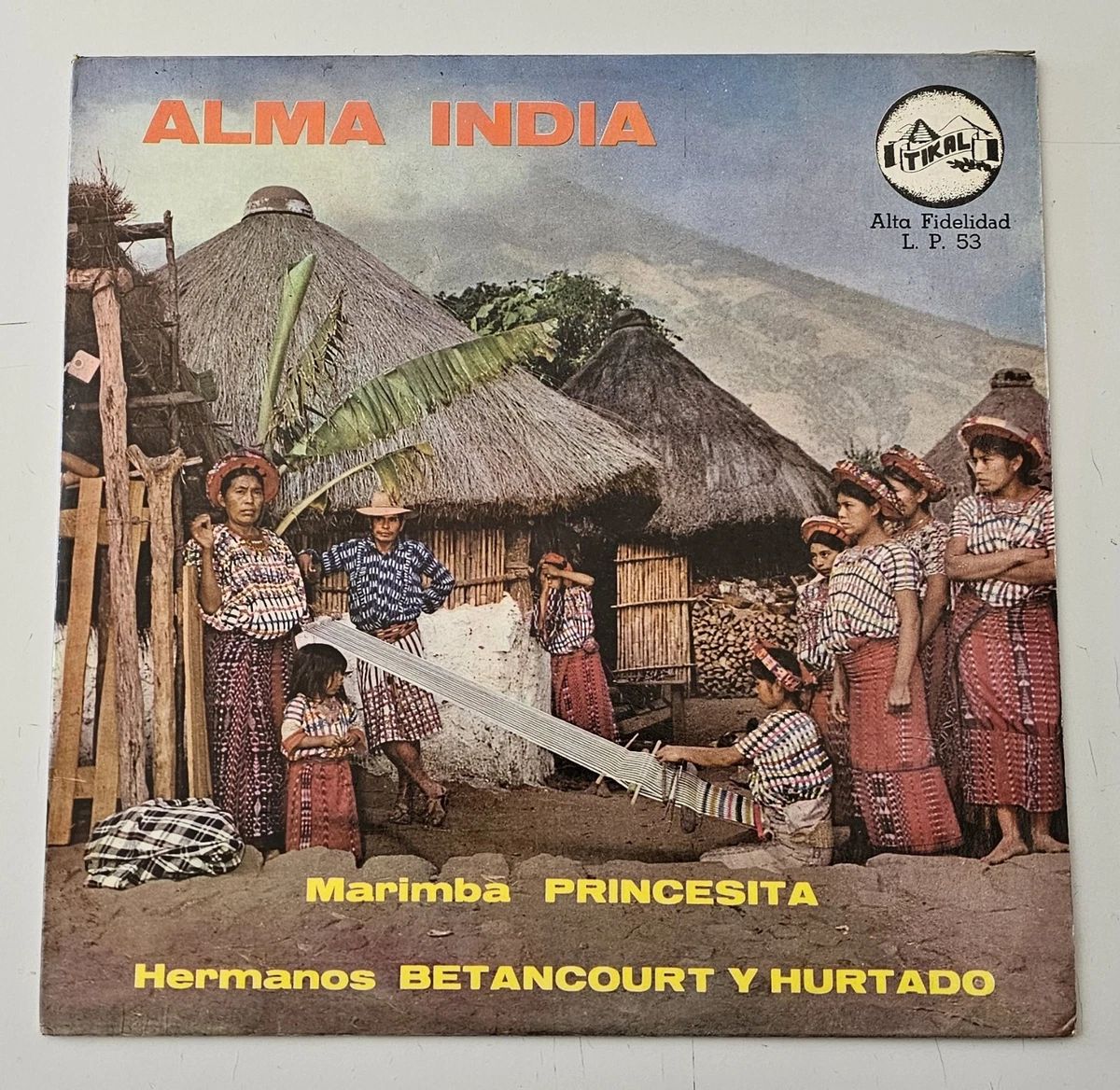

マヤ・マリンバ音楽用語集
Glossary of Mayan Marimba Music
/ El Barreño,
Compositor Toribio Hurtado (EPD)., Dirección y Arreglos del recordado y
muy querido maestro de música: Luis (Don Güichito) Hurtado.
池 田光穂
☆ Navarrete Pellicer, Sergio. 2005. Maya Achi Marimba Music In Guatemala. (Studies in Latin American and Caribbean Music). Temple University Press.から、アチのマリンバ音楽に関する用語集、Navarette Pellecer (2005:249-252)の箇所を引用、翻訳する。あわせて、ケクチ音楽のおける、類似点や相違点などについて検討するのか、このページの目的であ る。
書 物の紹介:「グアテマラ先住民であるマヤ系民族のひとつ、アチ族にとって、マリンバの音楽は娯楽の一形態としてだけでなく、コミュニケーションの一形態、 記憶の手段、文化的アイデンティティの明確化としても機能している。セルヒオ・ナバレテ・ペリセールは、アフリカ音楽の影響、スペインの植民地支配、イン ディアンの民族的同化の歴史的合流点であるマリンバの伝統を、アチ文化と社会の中心であるラビナルにおける文化の継続と変化の原動力として考察する。ナバ レテ・ペリセールは、マリンバ音楽の演奏と消費を、社会的相互作用、宗教的信仰、民族的アイデンティティのシステムの補完的な部分として考察することで、 マリンバの音色が、植民地時代の過去がもたらした政治的暴力と経済的苦難と折り合いをつけようとするアチ族の精神的渇望と文化的交渉にいかに共鳴している かを明らかにする」https://ci.nii.ac.jp/ncid/BA72925147
+
+
| ア
チ・スペイン語 |
日本語 |
Navarette Pellecer
(2005:249-252) |
邦訳 |
Q'eq'chi の対応語彙など注釈 |
| Abogado |
アボガード、パトロン(守護者) |
Advocate, surrogate agent
mediating between people and the
supernatural; prayer maker. Also called cabezante or devocionista
(head or leader and devotion maker). When a prayer maker leads a
cofradía ritual he is called teniente (lieutenant); when praying at
weddings
and anniversaries of the dead he is called padrino (godfather) or
tz'onowel' (petition maker). |
擁護者、人々と超自然的なものの間を仲介する代理人、祈祷師。カベサン
テ(cabezante)、デボシオニスタ(devocionista)とも呼ばれる。祈祷師がコフラディアの儀式を指導する場合は、teniente
(中尉)と呼ばれ、結婚式や死者の記念日に祈る場合は、padrino(ゴッドファーザー)またはtz'onowel'(嘆願者)と呼ばれる。 |
|
| Adufe |
アドゥフェ |
Square drum, called tupe in the
Achi language. |
アチ語でトゥペと呼ばれる四角い太鼓。 |
|
| Alegría |
アレグリア |
A Rabinalense social musical
occasion. |
アレグリア。本来は「よろこび」の意味だが、ラビナルの人たちは音楽が
演奏される機会をこう呼ぶ。 |
|
| Animas |
アニマ、死霊 |
Souls or spirits of the dead. |
死者の魂、あるいは精霊 |
|
| Bolero |
ボレロ |
A popular music piece of the
pieza genre. Originally a Spanish dance music form in triple meter. |
ピエサ(非伝統音楽)のジャンルの大衆音楽。もともとは、三拍子のダン
ス音楽。 |
|
| Cabo de año |
カーボ・デ・アーニョ |
Cabo de año (end of year).
Anniversary of the dead. Achi people commemorate
the death of their family members. A series of commemorations
that help the souls of deceased family members rest in peace
take place seven or nine days and forty days after death has occurred.
Subsequent commemorations occur on the first, seventh, and fourteenth
anniversaries of the death. After the fourteenth anniversary,
relatives'
obligations to the dead cease. |
(年の終わり)死者の記念日
アチの人々は家族の死を記念する。亡くなった家族の魂が安らかに眠れるよう、死後7、9日目と40日目に一連の追悼行事が行われる。その後、一周忌、七回
忌、十四回忌と続く。十四回忌を過ぎると、親族の死者に対する義務はなくなる。 |
|
| Calvario |
カルバリオ |
(Calvary). Chapel of the Lord of
mercy built at the entrance
of the main cemetery situated at the west end of town and facing
east toward the entrance of the main church in town. It is mainly
used by abogados on Mondays, when they pray for the souls of the
dead. |
ゴルゴダの丘のこと。(カルバリー)。町の西端に位置する主な墓地の入
り口に、町の主な教会の入り口に向かって東向きに建てられた慈悲の主の礼拝堂。主に月曜日にアボガードたちが死者の冥福を祈るために使用する。 |
ゴルゴダの丘のこと。各コミュニティには、カルバリオという小高い丘や 頂きなどに、礼拝所を設置して、イースターの時の巡拝の最終地にしている。 |
| Canción ranchera |
ランチェーラ歌謡 |
Mexican country songs. |
メキシコのフォーク・カントリーソングと、そのジャンルのこと。 |
|
| Chromatic marimba |
半音階マリンバ |
A marimba built with a
chromatic-scale keyboard. |
12音の半音階の演奏できる鍵盤からできているマリンバ | |
| Cofradía. |
コフラディーア |
In Latin America the cofradía
are sodalities or brotherhoods
that take care of the saints, including the organization of their
festivities.
There are sixteen indigenous cofradías in Rabinal. |
ラテンアメリカでは、コフラディーアは、聖人の祭りの組織化を含め、聖
人の世話をするソーダリティあるいは信徒会である。ラビナルには16の先住民のコフラディーアがある。 |
|
| Colear |
コレアール、伴奏 |
To follow; in marimba music the
harmony or center player and the bass player follow the leading part of
the treble player. |
伴奏すること:マリンバ音楽では、ハーモニー奏者またはセンター奏者と
ベース奏者が、高音奏者のリードパートに従う。 |
|
| Conjunto marimba |
コンフント・マリンバ、マリンバ奏団 |
An ensemble formed by a pieza
marimba for four players, a double bass, and a drum set. The conjunto
marimba plays all the urban popular repertoire. A few conjunto marimba
ensembles have a chromatic marimba instead of a diatonic pieza marimba. |
4人用のピエサ・マリンバ、コントラバス、ドラムセットで編成されるア
ンサンブル。コンフント・マリンバは、都会的でポピュラーなレパートリーを演奏する。いくつかのコンフント・マリンバ・アンサンブルは、ダイアトニック・
ピエサ・マリンバ(7音全音階鍵盤)の代わりにクロマチック・マリンバ(12音階鍵盤)を持っている。 |
|
| Contradanza |
コントラダンサ |
(contredanse). A ballroom dance
of the late eighteenth
century and first half of the nineteenth. The structure has two parts,
both of which have an eight-measure theme that repeats with variations,
including different endings. The dancers form two lines, one
in front of the other. Each dancer takes his turn, and turns alternate
between the two lines. Each dancer makes the same figures in crossing
to the other line. This piece is the theme played in the Costeño
dance-drama. |
(カウンターダンス)18世紀後半
から19世紀前半の社交ダンス。構成は2つのパートからなり、どちらも8小節の主題を持ち、異なる終止を含むバリエーションで繰り返される。ダンサーは2
列に並び、1人が前に出る。各ダンサーが順番に踊り、2つのラインの間で交互に交代する。各ダンサーは、もう一方のラインと交差する際に同じポーズを取
る。この曲は、コステーニョの舞踊劇で演じられるテーマである。 |
|
| Corrido |
コリード |
(1) A popular musical piece of
the pieza genre derived from the
polka dance music of the border between Mexico and the United
States; (2) a style of playing the bass voice of the marimba,
consisting
of playing a chord simultaneously with both hands. |
コリードとは、(1)メキシコとアメリカの国境のダンス音楽ポルカから
派生した外来音楽(ピエサ)ジャンルのポピュラー音楽。(2)マリンバの低音部を両手で同時に和音を奏でるスタイル。 |
|
| Costeño |
コステーニョ |
The favorite traditional
dance-drama of Rabinal. It is danced to marimba music. |
ラビナルで人気のある伝統的なダンスドラマ。マリンバの音楽に合わせて
踊られる。 |
|
| Cuchubal |
クチュバル |
Partnership in a task or
business. |
クチュバルとは、仕事や事業におけるパートナーシップのこと。 |
|
| Cumbia |
クンビア |
A popular Afro-Caribbean
dance-music piece considered a pieza in Rabinal. It originated in
Colombia. |
ラビナルではピエサと呼ばれるアフロ・カリビアン・ダンス・ミュージッ
クの人気曲。コロンビア発祥。 |
|
| Danza |
ダンス、舞踊曲 |
An eighteenth-century dance
piece called danza de la muerte
(death dance) played in the Animalitos dance-drama. It is a bolero
dance in triple meter, with an A-B-A-B-B-A structure. The piece is
danced by a couple of animal characters holding arms, side by side, in
a slow walking motion. |
18世紀の舞踊劇『アニマリートス』で踊られたダンサ・デ・ラ・ムエル
テ(死の舞踏)と呼ばれる舞踊曲。A-B-A-B-B-Aの3拍子のボレロ・ダンスである。この曲は、動物のカップルが腕を組み、横に並んで、ゆっくりと
歩くように踊る。 |
|
| Double Marimba |
ダブル・マリンバ |
A set of two marimbas, a large
one called the marimba
grande for four players and a smaller one called tenor for three
players.
Both marimbas have chromatic-scale keyboards and can therefore
be used to play any musical piece composed in more than one key or
tonality.
|
マリンバ・グランデと呼ばれる4人用の大型マリンバと、テナーと呼ばれ
る3人用の小型マリンバの2本セット。どちらのマリンバも半音階の鍵盤を持っているため、複数の調や調性で作曲されたあらゆる楽曲を演奏することができ
る。 |
|
| Dueño |
ドゥエーニョ、主 |
Spirit owner of the world, and
of all things on earth. |
世界と地上の万物の霊の所有者 |
|
| Encadenarse |
エンカデナールセ、こんがらがる |
An
error in musical performance that happens when the bass and/or harmony
marimba musicians play behind and not simultaneously with the treble
player. |
低音奏者や和声マリンバ奏者が高音奏者と同時に演奏せず、後方で演奏す
る場合に起こる演奏上の誤り。 |
|
| Guaracha |
グアラチャ |
A popular type of dance music
considered part of the pieza genre in Rabinal, originating in Puerto
Rica and Cuba. |
プエルトリコとキューバが発祥で、ラビナルでは外来音楽(ピエサ)の一
ジャンルとされるポピュラーなダンス音楽の一種。 |
|
| Interval |
インターバール |
The
distance between two pitches or the sound frequency difference between
two pitches, which may be measured in a number of whole tones and
semitones. |
2つの音高間の距離、または2つの音高間の音の周波数差で、全音や半音
の数で測定されることがある。 |
|
| Jalar |
ハラール、リードする |
To
pull; as a musical term this refers to the treble player's leading a
marimba ensemble; the complementary response to this is the colear or
following by the remaining two players. |
引っ張ること。音楽用語としては、高音奏者がマリンバ・アンサンブルを
リードすることを指す。これに対する補完的な対応が、残りの2人の演奏家によるクリアまたはフォロー(伴奏)である。 |
|
| Ladino |
ラディーノ |
Non-Indian, or person who does
not follow the Indian tradition. |
ラディーノとは、(先住民からみて)非先住民、または先住民の伝統に従
わない人。 |
|
| Marcado |
メルカード |
A style of playing the bass part
of the marimba as an arpeggio or as a melodic formula. |
メルカードとは、本来、定期市や市場のことであるが、ここで言うのは、
マリンバの低音部をアルペジオとして、あるいは旋律式として演奏するスタイルのことをさす。 |
|
| Merengue |
メレンゲ |
A popular dance-music piece
considered a pieza in Rabinal. This originated in the Dominican
Republic. |
ラビナルではピエサ(外来音楽)と呼ばれるポピュラーなダンス音楽。ド
ミニカ共和国発祥。 |
|
| Mestizo |
メスティーソ |
Person of mixed race. Equivalent
to Ladino. |
混血の人。ラディーノと同じ意味をもつ。 |
|
| Mozo |
モソ |
A
contract worker. A marimba mozo is an individual with experience and
knowledge of the musical repertory who offers his services for an event
to marimba owners who are missing a player. |
(本来は)契約労働者。マリンバ・モソとは、音楽のレパートリーに関す
る経験と知識を持ち、奏者が不足しているマリンバ・オーナーにイベントのためのサービスを提供すために代役で入る演奏家のことである。 |
|
| Pasillo |
パシージョ |
A popular dance-music piece of
the pieza genre. |
外来音楽(ピエサ)に分類される、大衆ダンス音楽。 |
|
| Pieza |
ピエサ |
A term used by Achi Rabinalenses
to refer to all popular urban music as a genre. |
ピエサ(外来音楽)とは、ラビナルのアチの人たちがポピュラーなアーバ
ン・ミュージック全般をジャンルとして指すときに使う言葉。 |
|
| Pieza marimba |
ピエサ・マリンバ |
A diatonic marimba used for the
repertoire of piezas. It has forty-two keys arranged in a diatonic
scale and is played by four musicians. |
ピエサのレパートリーに使われるダイアトニック(全音階)マリンバ。全
音階のスケールに配置された42のキーを持ち、4人の奏者で演奏される。 |
|
| Simple marimba |
シンプル・マリンバ |
A diatonic marimba with forty
keys for three players in the case of the son marimba, or forty-two
keys, for three or four players, in the case of the pieza marimba,
which is also used for the conjunto marimba ensembles. |
ダイアトニック(全音階)マリンバで、ソン・マリンバの場合は3人用の
40キー、ピエサ・マリンバの場合は3人または4人用の42キーがあり、コンフント・マリンバのアンサンブルにも使われる。 |
|
| Siuanaba |
シウアナーバ |
A female evil spirit who appears
before drunken men, especially young men, who have a strong sexual
desire for women other than their wives or girlfriends. She is the
devil, or death, disguised as a beautiful woman and lures men to their
death. |
シウアナーバとは、妻や彼女以外の女性に強い性的欲求を抱く酔った男
性、特に若い男性の前に現れる女性の悪霊。美しい女性に化けた悪魔、あるいは死であり、男たちを死へと誘う。 |
アチ語のシウアナーバは、スペイン語でのジョローナ(泣き女)の相当す
る幽霊かもしれない。 |
| Son | ソン |
A traditional dance-music genre
that is believed to be the music of the ancestors. It may be played by
different types of musical ensembles, but the largest repertoire of
sones is played on the diatonic marimba at a moderate to rapid tempo,
combining elements of compound duple and simple triple metres. The form
has two to four eight-measure sections that repeat in different order. |
ソンは、アチの人にとって祖先音楽と信じられている伝統的な舞踊音楽の
ジャンル。さまざまなタイプの音楽アンサンブルによって演奏されるが、ソネス(ソンの複数形)の最大のレパートリーは、ダイアトニック(全音階)マリンバ
を用い、複合二重音と単純三重音の要素を組み合わせて、中速から速めのテンポで演奏される。この形式には2~4つの8小節のセクションがあり、異なる順序
で繰り返される。 |
|
| Son con cera |
ソン・コン・セラ |
A type of son played in the key
adjacent to the original key of the diatonic marimba. Musicians place
little balls of wax under the keys of the seventh degree of the
diatonic scale keyboard of the diatonic marimba. The wax lowers the
pitch of the keys by approximately half a tone, thereby changing the
keyboard scale to a neighboring tonality (e.g., C to F major). Sones
sin cera (without wax) are all those sones played in the original key
of the diatonic marimba. |
ソ
ン・コン・セラ(ワックスつきのソン)とは、全音階(ダイアトニック)マリンバの原調に隣接する調で演奏されるソンの一種。音楽家は、全音階マリンバの全
音階スケールの鍵盤の7度の鍵盤の下に小さな蝋の玉を置く。蝋は鍵盤の音程を約半音下げ、それによって鍵盤の音階を隣の調性(例えばハ長調からヘ長調)に
変える。Sones sin cera(ワックスなしのソン曲)は、全音階マリンバの原音で演奏されるすべての音である。 |
|
| Son de dos baquetas |
ソン・デ・ドス・バンケタス(2つばち(マレット)のソン) |
(two-mallet son). A type of son
classified according to the number of mallets used by the middle
player, who carries the harmony on the son marimba. The middle player
may use two, three, or four mallets, depending on the complexity of the
harmony; accordingly there are two-, three-, and four-mallet sones. |
(2つのバチを同時に握るソン)。ソンの一種で、和声をソンマリンバで
奏でる中間奏者が使用するマレット(ばち)の数によって分類される。中間奏者はハーモニーの複雑さに応じて、2本、3本、4本のマレット(ばち)を使用す
る。 |
|
| Son marimba |
ソン・マリンバ |
A diatonic marimba used
for the repertoire of sones. It has forty keys arranged in a diatonic
scale and is played by three musicians. |
ソン曲のレパートリーに使われる全音階(ダイアトニック)
マリンバ。全音階スケールに配列された40のキーを持ち、3人の奏者によって演奏される。 |
|
| Tiple |
ティプレ |
Marimba treble player or
position. |
マリンバ高音奏者または、そのポジションのこと。 |
|
| Tupe |
トゥペ |
Square drum, called adufe in
Spanish. The tupe and violin form an ensemble. |
スペイン語でアデュフェと呼ばれる四角い太鼓。トゥペとヴァイオリンが
アンサンブルを組む。 |
|
| Vuelta |
ヴゥエルタ、返し |
Musical term with multiple
meanings. It may refer to the ornamentation of a melody, to a section,
strophe, or part of the piece, to a variation, chorus, or repetition of
a section, or to an improvisatory style. |
複数の意味を持つ音楽用語。旋律の装飾、セクション、ストローフ、曲の
一部、変奏、合唱、セクションの繰り返し、即興的なスタイルを指すこともある。 |
|
| Zarabanda |
サラバンダ |
Sarabande; in contemporary
Rabinal this refers to a socialgathering where people drink and dance
to the son marimba. |
サラバンド;現代のラビナルでは、マリンバに合わせて酒を飲み踊る社交
の場を指す。 |
サラバンド(Sarabande)のもともとの意味は、17-18世紀
のスペイン宮廷の舞踊曲からきている。社交ダンスホールの名前のことでもあり、また、そこで演奏される楽曲なども意味するのだろう。 |
リ ンク
文 献
そ の他の情報

Acknowledgement;
This work was supported by JSPS KAKENHI Grant Number 21K18363.
Copyleft, CC, Mitzub'ixi Quq Chi'j, 1996-2099
☆
 ☆
☆